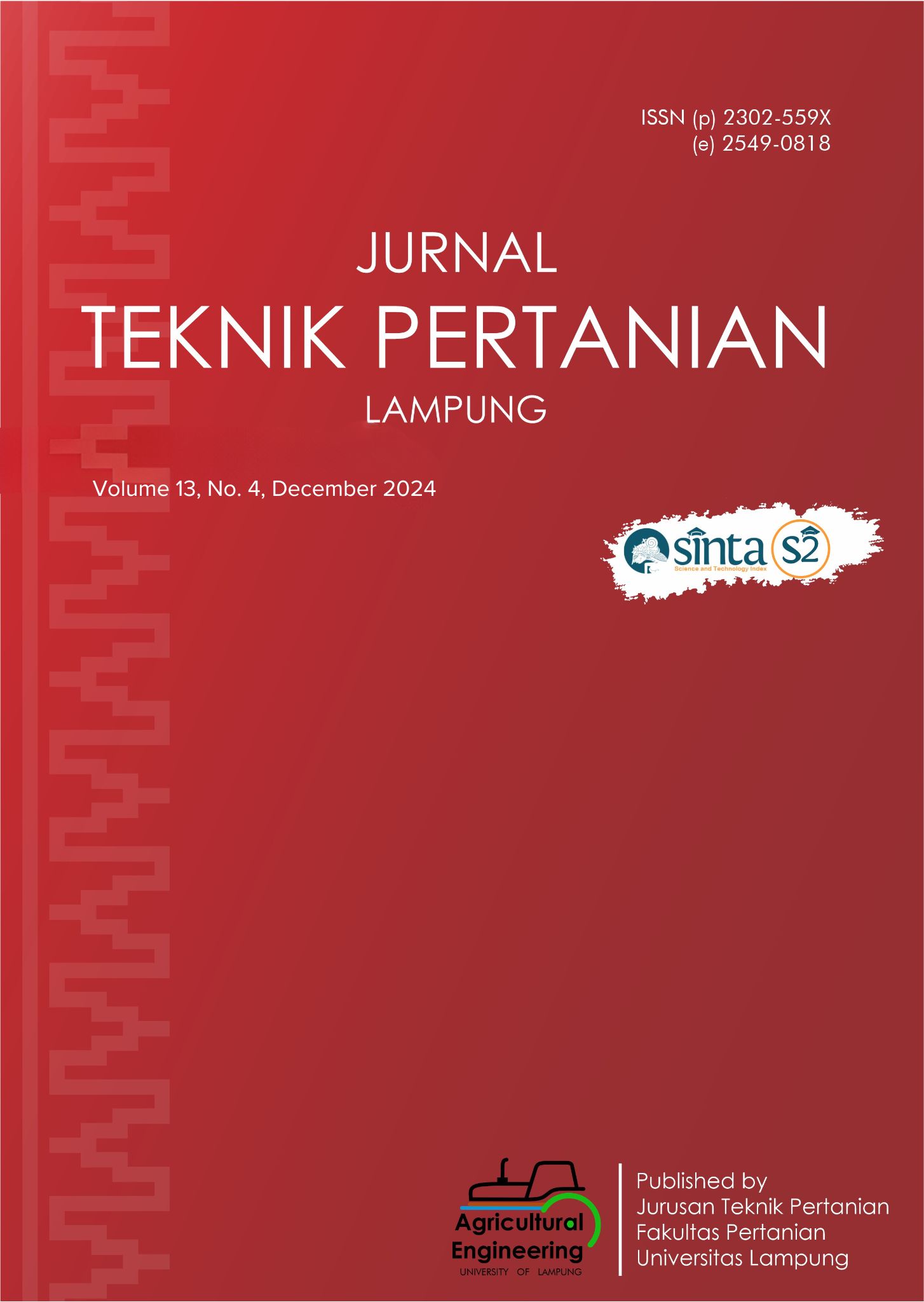Increasing Physical Soil Quality by Using Rice Straw Biomass
DOI:
https://doi.org/10.23960/jtep-l.v13i4.1006-1012Abstract
Paddy straw as an agricultural waste can be returned to the soil to increase the organic matter content. This study aims to determine the optimum inoculant treatment of rice paddy straw on soil quality. The straw handling was carried out by spreading the straw on paddy fields and sprayed with four inoculant treatments (0, 3, 6, 9, and 12 L/ha). The incubation process was carried out for 21 days and incorporated in the soil through plowing. Each treatment was repeated three times so that the total treatment was 15 units. The variables observed in each treatment were soil quality. The soil quality parameters observed were particle density, bulk density, porosity, field capacity and pH. ANOVA statistical analysis which was continued by the Tukey HSD Post Hoc Test to determine the effect of treatment on soil quality. The results showed that the inoculant treatments showed a significant difference (p-value=0.05) in soil volume, density, and porosity. P4 gave the optimum results which are statistically not significantly different from P3. P4 shows the physical properties of the soil which consist of the soil bulk density of 0.61 g/cm3; particle density 1.74 g/cm3; porosity was 64.91%, and pH 6.68. The utilization of straw biomass as source of organic material contributes to zero waste rice cultivation.
Keywords: Effective microorganisms, Rice straw, Soil density, Soil pH, Soil porosity.
References
Anwar, K., Sabiham, S., Sumawinata, B., Sapei, A., & Lihamsyah, T. (2006). Pengaruh kompos jerami terhadap kualitas tanah, kelarutan Fe2+ dan SO4 2- serta produksi padi pada tanah sulfat masam. Jurnal Tanah dan Iklim, 2(4), 29–39.
Asandhi, A.A., Nuratika, N., & Sumami, N. (2005). Optimasi pupuk dalam usaha tani LEISA bawang merah di dataran rendah. Jurnal Hortikultura, 15(3), 199-207.
Bintoro, A., Widjajanto, D., & Isrun, I. (2017). Karakteristik fisik tanah pada beberapa penggunaan lahan di Desa Beka Kecamatan Marawola Kabupaten Sigi. Agrotekbis, 5(4), 423–430.
Buckman, H.O., & Brady, N.C. (1982). Ilmu tanah (translated by Soegiman). Bhratara Karya Aksara, Jakarta: 788 pp.
Cahyadewi, P., Diara, & Arthagama, I. (2016). Uji kualitas tanah dan arahan pengelolaannya pada budidaya padi sawah di Subak Jatiluwih, Penebel, Tabanan. E-Jurnal Agroekoteknologi Tropika (Journal of Tropical Agroecotechnology), 5(3), 232–242.
Gbenou, P., Mitchel, A.M., Sedami, A.B., & Agossou, P.N. (2016). Farmer evaluations of the system of rice intensification (SRI) compared with conventional rice production in Benin. European Scientific Journal [ESJ], 12(30), 280-296.
Hanudin, E. (2000). Pedoman Analisis Kimia Tanah. Jurusan Tanah, Fakultas Pertanian, UGM, Yogyakarta.
Hardjowigeno, S. (1986). Genesis dan Klasifikasi Tanah. Jurusan Tanah, Fakultas Pertanian, IPB, Bogor.
Hillel, D. (1980). Fundamental of Soil Physics. Academic Press. https://doi.org/https://doi.org/10.1016/C2009-0-03109-2
Liebman, M., & Davis, A.S. (2000). Integration of soil, crop and weed management in low-external-input farming systems. Weed Research, 40(1), 27–47. https://doi.org/10.1046/j.1365-3180.2000.00164.x
Manuputty, M.C., Jacob, A., & Johanis, P. (2012). Pengaruh effective inoculant promi dan EM4 terhadap laju dekomposisi dan kualitas kompos dari sampah Kota Ambon. Agrologia, 1(2), 143-151 http://dx.doi.org/10.30598/a.v1i2.290
Mustikarini, E.D., & Santi, R. (2020). Strategi pemberdayaan petani lahan cetak sawah baru melalui LEISA. Society, 8(1), 25–38. https://doi.org/10.33019/society.v8i1.143
Omwenga, K.G., Mati, B., & Home, P. (2014). Determination of the effect of the system of rice intensification (SRI) on rice yields and water saving in Mwea Irrigation Scheme, Kenya. Journal of Water Resource and Protection, 6(10), 895–901. http://dx.doi.org/10.4236/jwarp.2014.610084
Pairunan, A.K., Nanere, J., Arifin, S.S., Samosir, R.T., Lalopua, J., Ibrahim, B., & Asmadi, H. (1985). Dasar-Dasar Ilmu Tanah. Ujung Pandang: BKPT INTIM.
Pita, P.L.R., Sumiyati, & Nada, I.M. (2016). Aplikasi metode SRI (system rice of intensification) dan sistem tanam jajar legowo terhadap iklim mikro yang mempengaruhi produktivitas padi beras merah. Biosistem dan Teknik Pertanian (BETA), 4(1), 1–12.
Plaster, E.J. (2003). Soil Science and Management (4th ed.). Delmar Cengage Learning, Clifton Park, NY, USA: 400 pp.
Rahim, S.E. (2000). Pengendalian Erosi Tanah Dalam Rangka Pelestarian Lingkungan Hidup. Bumi Aksara, Jakarta: 150 PP.
Sanjaya, I.P., Tika, I.W., & Sumiyati. (2014). Pengaruh teknik budidaya SRI (system of rice intensification) dan legowo terhadap iklim mikro dan produktivitas padi ketan. Biosistem dan Teknik Pertanian (BETA), 2(1), 1–10.
Setiawati, W., Muharam, A., Susanto, A., Boes, E., & Hudayya, A. (2019). Penerapan teknologi input luar rendah pada budidaya cabai merah untuk mengurangi penggunaan pupuk dan pestisida sintetik. Jurnal Hortikultura, 28(1), 113. https://doi.org/10.21082/jhort.v28n1.2018.p113-122
Setiyo, Y., Gunadnya, I.B.P., Gunam, I.B.W., & Susrusa, I.K.B. (2017). The implementation of low external input sustainable agriculture system to increase productivity of potato (Solanum tuberosum L.). Journal of Food, Agriculture and Environment, 15(2), 62–67.
Seybold, C.A., Mausbach, M.J., Karlen, D.L., & Rogers, H.H. (2018). Quantification of soil quality. Soil Processes and The Carbon Cycle, 387–404. https://doi.org/10.1201/9780203739273
Tamara, W.R., Sumiyati, S., & Wijaya, I.M.A.S. (2020). Analisis kualitas sifat fisik tanah pada lahan subak di Bali. Jurnal BETA (Biosistem dan Teknik Pertanian), 8(2), 358. https://doi.org/10.24843/jbeta.2020.v08.i02.p21
Tripp, R. (2005). The performance of low external input technology in agricultural development: A summary of three case studies. International Journal of Agricultural Sustainability, 3(3), 143–153.
Tripp, R. (2006). Is low external input technology contributing to sustainable agricultural development? Sida, 102, 1-4.
Downloads
Published
Issue
Section
License
- Authors who publish with this journal agree to the following terms:
- Authors retain copyright and grant the journal right of first publication with the work simultaneously licensed under a Creative Commons Attribution-ShareAlike 4.0 International Lice that allows others to share the work with an acknowledgement of the work's authorship and initial publication in this journal.
- Authors are able to enter into separate, additional contractual arrangements for the non-exclusive distribution of the journal's published version of the work (e.g., post it to an institutional repository or publish it in a book), with an acknowledgement of its initial publication in this journal.
- Authors are permitted and encouraged to post their work online (e.g., in institutional repositories or on their website) prior to and during the submission process, as it can lead to productive exchanges, as well as earlier and greater citation of published work (See The Effect of Open Access).
Jurnal Teknik Pertanian Lampung

JTEPL is licensed under a Creative Commons Attribution-ShareAlike 4.0 International License.

